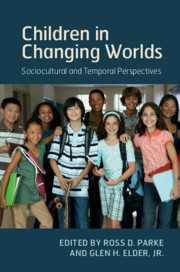Book contents
- Children in Changing Worlds
- Children in Changing Worlds
- Copyright page
- Contents
- List of Figures
- Contributor Biographies
- Preface
- Part I Theoretical and Methodological Approaches: A Cross-Disciplinary Challenge
- Part II Historical and Life Course Transitions: Economic and Demographic Change
- 2 When Societal Events Occur in Lives: Developmental Linkages and Turning Points
- 3 Entering Adulthood in the Great Recession: A Tale of Three Countries
- 4 Developmental Risk and Resilience in the Context of Devastation and Forced Migration
- 5 Children’s Migratory Paths Between Cultures: The Effects of Migration Experiences on the Adjustment of Children and Families
- 6 Education in Historical and Cultural Perspective
- Part III Social, Legal, and Technological Change: Impact on Children
- Part IV Views of the Interdisciplinary Dialogue: From Developmental Science and Sociology
- Author Index
- Subject Index
- References
6 - Education in Historical and Cultural Perspective
from Part II - Historical and Life Course Transitions: Economic and Demographic Change
Published online by Cambridge University Press: 18 July 2019
- Children in Changing Worlds
- Children in Changing Worlds
- Copyright page
- Contents
- List of Figures
- Contributor Biographies
- Preface
- Part I Theoretical and Methodological Approaches: A Cross-Disciplinary Challenge
- Part II Historical and Life Course Transitions: Economic and Demographic Change
- 2 When Societal Events Occur in Lives: Developmental Linkages and Turning Points
- 3 Entering Adulthood in the Great Recession: A Tale of Three Countries
- 4 Developmental Risk and Resilience in the Context of Devastation and Forced Migration
- 5 Children’s Migratory Paths Between Cultures: The Effects of Migration Experiences on the Adjustment of Children and Families
- 6 Education in Historical and Cultural Perspective
- Part III Social, Legal, and Technological Change: Impact on Children
- Part IV Views of the Interdisciplinary Dialogue: From Developmental Science and Sociology
- Author Index
- Subject Index
- References
Summary
Education is a powerful determinant of young people’s futures and a key developmental context of their daily lives, but education is changing. The recent restructuring and globalization of the economy have increased the lifelong benefits of higher education in the US and many other developed countries, which in turn has created downward pressure on earlier stages of the educational systems. This chapter describes economic restructuring, its effects on returns to higher education and curricular differentiation, and what these effects mean for inequality in a globalizing and diversifying world. It then shifts attention to different kinds of policy and programmatic responses to inequality in a changing educational context, focusing on strategies to change schools, change curricula in schools, change connections between schools and families, and change the psychology of young people. The goal is to explore ways that developmentally informed, culturally responsive, and multilevel solutions can be developed to promote equality of opportunity and educational equity.
Keywords
- Type
- Chapter
- Information
- Children in Changing WorldsSociocultural and Temporal Perspectives, pp. 131 - 162Publisher: Cambridge University PressPrint publication year: 2019

